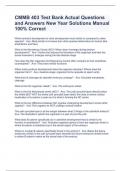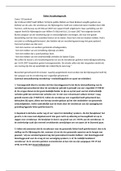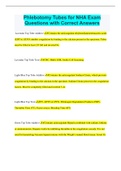CMMB 403 Test Bank Actual Questions and Answers New Year Solutions Manual
100% Correct
Which animal's development is chick development most similar to compared to other species? Ans- Most similar to humans than other species talked about in lecture (like amphibians and flies)
What is the Nieuwkoop Centre (NC)? When does it emerge during embryo development? Ans- Centre that induces the formation of the organizer and later the dorsal mesoderm; emerges during the late blastula stage
How does the fish organizer and Niewukoop Centre (NC) compare to their amphibian counterparts? Ans- They have similar functions
When during embryo development does the organizer develop? Where does the organizer form? Ans- Gastrula stage; organizer forms opposite to sperm entry
What kind of cleavage do zebrafish embryos undergo? Ans- Discoidal meroblastic cleavage
What is the fish organizer called? Ans- The embryonic shield
What is the fish Nieuwkoop centre (NC)? Ans- The yolk syncytial layer directly below the shield (BUT NOT the entire yolk syncytial layer itself); this area is where nuclear localization of b-catenin is seen as it is what is forming the NC centre
What is the key difference between fish zygotes undergoing development versus other zygotes? Ans- Fish zygotes do NOT undergo cortical rotation
The yolk syncytial layer is at the margin between what 2 things in the zebrafish embryo?
Ans- The blastoderm (which the organizer is a part of) and the yolk
What does B-catenin specifically do in zebrafish development that is similar to its function in amphibians? Ans- Activates organizer genes to form the organizer which is where B-catenin is stabilized (up in the dorsal region of the embryo)
Where is nuclear B-catenin specifically found in the embryo? Ans- Below the future embryonic shield (in the yolk syncytial layer beneath the future embryonic shield) which is where B-catenin marks as the dorsal side of the embryo What does nuclear localization of B-catenin do and what does it help to form? Ans- Nuclear localization of b-catenin marks the dorsal side of the Xenopus blastula and helps form its Nieuwkoop center beneath the organizer
What happens to the future embryonic shield after nuclear B-catenin is stabiliized below
it? Ans- Future embryonic shield above the nuclear B-catenin cells thicken to become the organizer
How do the molecules involved in zebrafish development (ie. organizer formation, etc) relate to the ones used in amphibians? Ans- They are homologous
What 2 organizer genes does B-catenin activate expression of in zebrafish? What kind of proteins do each of these 2 genes express? Expression of these leads to expression of what molecules? Ans- B-catenin activates expression of squint (which is nodal-like) and bozozok (which is a homeodomain that also happens to be siamois ortholog)
Squint and bozozok both activate expression of chordino (a BMP inhibitor in zebrafish) as well as noggin, goosecoid, dickkopf (Wnt inhibitors)
What is the mechanism of beta catenin accumulation in zebrafish? What movements were found to be not detected? Ans- Mechanism of beta-catenin accumulation in zebrafish is unknown - no cortical rotation or other morphogenetic movements have been detected
Nuclear beta catenin has a direct effect on chordino expression (True/False) Ans- False, beta catenin affects chordino expression indirectly through squint (nodal-like protein) and bozokok (homeoprotein) homologues
What is squint a homologue of? What is bozokok a homologue of? Ans- Squint is a homologue of Nodal (TGF beta paracrine factor)
Bozokok is a homologue of siamois
At the blastula stage, what is going on with the Nieuwkoop center? Ans- There is nuclear beta-catenin accumulation at the Nieuwkoop center
Between zebrafish and Xenopus, which has a smaller embryo? Ans- Zebrafish embryo
is smaller
Gastrulation in aminiote embryos occurs through what structure? What does this structure contain? Ans- A linear structure called the primitive streak (a characteristic feature of all amniote embryos) which contains a groove through which cells ingress to form the endoderm and mesoderm
Cells (from the epiblast) that ingress through the primitive streak form what? Cell that don't ingress through the primitive streak form what? Ans- Cells that ingress through the primitive streak form the mesoderm and the endoderm while cells that DON'T ingress through the primitive streak form the ectoderm Which cells of the embryo serve as the amniote organizer? Ans- The cells of Henson's node (aka the node in mammals) which is at the anterior end of the primitive streak
What is Henson's node? What structure of the chick embryo does this represent? Ans-
A thickening of cells at the anterior end of the primitive streak; these cells represent the chick organizer
Because Hensen's node serves as the amniote organizer, what does this mean for Hensen's node? Ans- Means that Hensen's node is a source of cells expressing BMP inhibitors
Compared to other embryos, how do early amniote embryos appear more in structure? Ans- Rather flat compared to others
What is the role of the blastopore in forming the primitive streak? Ans- The blastopore is like a circle that has collapsed to become the primitive streak which gastrulation occurs through
What are amniotes and how do they differ from non-amniotes? Ans- An amniote has an amnion; the amnion allows development to take place outside of water, by providing an aqueous environment within a sac to support development
Does the human yolk sac contain yolk? What is the importance of the human yolk sac? Ans- Human yolk sac doesn't contain any yolk but the yolk sac is important for providing
nutrients to the early developing embryo before the placenta eventually takes over for that responsibility
What is the chorion? Ans- Functions in gas exchange with the embryo and forms part of the placenta
What do all amniotes have? What is one thing that may or may not be present in certain
amniotes? Ans- All amniotes have an amnion, chorion, yolk sac and allantois; the placenta, however, is not always present
What characterizes reptiles, birds, and mammals? Ans- The membranes of the amniote egg (the 3 types of organisms are able to develop because of these membranes rather than having to be in water)
Studies of which two animals have contributed to our understanding of human development? Ans- Avian and mouse studies
What does the allantois of the amnion do? Ans- Stores wastes
How does the chorion facilitate gas exchange? Ans- Blood vessels in the chorion exchange gases and nutrients from the yolk sac How does nutrient and gas exchange differ in mammals compared to chicks? Ans- In mammals, the blood vessels acquire nutrients and exchange gases via a placenta joined to the mother's uterus rather than from the yolk sac
What is the placental yolk sac in mammals (even without yolk) still important for if not for
nutrient or gas exchange? Ans- Still has numerous developmental factors for humans for instance (like making blood and other things)
What is a blastodisc? What does it form? Ans- A region on the surface of the yolk where early embryonic cell divisions occur and is crucial for the development of the embryo in species like chicks; the blastodisc forms the body
What do the cells of the area pellucida make up? Ans- The epiblast from which the body of the embryo develops
What is the hypoblast? Ans- A second layer (epiblast is the first) of the early chick embryo; this layer forms from the single layer of thin cells that made up the epiblast but later forms the second layer that is the hypoblast
As soon as the egg of a chick is laid, how many cells do we have in its embryo? Ans- About 50,000 cells
How are we able to see the area pellucida in an amniote embryo? Ans- It is the more transparent part which is at the center of the embryo
At which part of the embryo does the primitive streak start to form from? Ans- From the
posterior of the embryo
In regards to the primitive streak, what event all occur within the span of a day? Explain the details of these event and what structures are formed as a result. Ans- Gastrulation
of cells through the primitive streak; cells that migrate through the node of the streak will
migrate inside the embryo more in the anterior direction, causing anterior structures to form while cells that migrate through the posterior end of the streak will go to form the more posterior structures of the embryo
From what view of the amniote embryo are we able to see the blastodisc? Ans- From looking down dorsally on the embryo
What is the amniote embryo's primitive streak a homolog of? Ans- The amphibian blastopore
What is Koller's sickle? Ans- A thick area at the posterior edge of the area pellucida
When is the anterior-posterior axis of the amniote embryo defined? Ans- Once the primitive streak appears
100% Correct
Which animal's development is chick development most similar to compared to other species? Ans- Most similar to humans than other species talked about in lecture (like amphibians and flies)
What is the Nieuwkoop Centre (NC)? When does it emerge during embryo development? Ans- Centre that induces the formation of the organizer and later the dorsal mesoderm; emerges during the late blastula stage
How does the fish organizer and Niewukoop Centre (NC) compare to their amphibian counterparts? Ans- They have similar functions
When during embryo development does the organizer develop? Where does the organizer form? Ans- Gastrula stage; organizer forms opposite to sperm entry
What kind of cleavage do zebrafish embryos undergo? Ans- Discoidal meroblastic cleavage
What is the fish organizer called? Ans- The embryonic shield
What is the fish Nieuwkoop centre (NC)? Ans- The yolk syncytial layer directly below the shield (BUT NOT the entire yolk syncytial layer itself); this area is where nuclear localization of b-catenin is seen as it is what is forming the NC centre
What is the key difference between fish zygotes undergoing development versus other zygotes? Ans- Fish zygotes do NOT undergo cortical rotation
The yolk syncytial layer is at the margin between what 2 things in the zebrafish embryo?
Ans- The blastoderm (which the organizer is a part of) and the yolk
What does B-catenin specifically do in zebrafish development that is similar to its function in amphibians? Ans- Activates organizer genes to form the organizer which is where B-catenin is stabilized (up in the dorsal region of the embryo)
Where is nuclear B-catenin specifically found in the embryo? Ans- Below the future embryonic shield (in the yolk syncytial layer beneath the future embryonic shield) which is where B-catenin marks as the dorsal side of the embryo What does nuclear localization of B-catenin do and what does it help to form? Ans- Nuclear localization of b-catenin marks the dorsal side of the Xenopus blastula and helps form its Nieuwkoop center beneath the organizer
What happens to the future embryonic shield after nuclear B-catenin is stabiliized below
it? Ans- Future embryonic shield above the nuclear B-catenin cells thicken to become the organizer
How do the molecules involved in zebrafish development (ie. organizer formation, etc) relate to the ones used in amphibians? Ans- They are homologous
What 2 organizer genes does B-catenin activate expression of in zebrafish? What kind of proteins do each of these 2 genes express? Expression of these leads to expression of what molecules? Ans- B-catenin activates expression of squint (which is nodal-like) and bozozok (which is a homeodomain that also happens to be siamois ortholog)
Squint and bozozok both activate expression of chordino (a BMP inhibitor in zebrafish) as well as noggin, goosecoid, dickkopf (Wnt inhibitors)
What is the mechanism of beta catenin accumulation in zebrafish? What movements were found to be not detected? Ans- Mechanism of beta-catenin accumulation in zebrafish is unknown - no cortical rotation or other morphogenetic movements have been detected
Nuclear beta catenin has a direct effect on chordino expression (True/False) Ans- False, beta catenin affects chordino expression indirectly through squint (nodal-like protein) and bozokok (homeoprotein) homologues
What is squint a homologue of? What is bozokok a homologue of? Ans- Squint is a homologue of Nodal (TGF beta paracrine factor)
Bozokok is a homologue of siamois
At the blastula stage, what is going on with the Nieuwkoop center? Ans- There is nuclear beta-catenin accumulation at the Nieuwkoop center
Between zebrafish and Xenopus, which has a smaller embryo? Ans- Zebrafish embryo
is smaller
Gastrulation in aminiote embryos occurs through what structure? What does this structure contain? Ans- A linear structure called the primitive streak (a characteristic feature of all amniote embryos) which contains a groove through which cells ingress to form the endoderm and mesoderm
Cells (from the epiblast) that ingress through the primitive streak form what? Cell that don't ingress through the primitive streak form what? Ans- Cells that ingress through the primitive streak form the mesoderm and the endoderm while cells that DON'T ingress through the primitive streak form the ectoderm Which cells of the embryo serve as the amniote organizer? Ans- The cells of Henson's node (aka the node in mammals) which is at the anterior end of the primitive streak
What is Henson's node? What structure of the chick embryo does this represent? Ans-
A thickening of cells at the anterior end of the primitive streak; these cells represent the chick organizer
Because Hensen's node serves as the amniote organizer, what does this mean for Hensen's node? Ans- Means that Hensen's node is a source of cells expressing BMP inhibitors
Compared to other embryos, how do early amniote embryos appear more in structure? Ans- Rather flat compared to others
What is the role of the blastopore in forming the primitive streak? Ans- The blastopore is like a circle that has collapsed to become the primitive streak which gastrulation occurs through
What are amniotes and how do they differ from non-amniotes? Ans- An amniote has an amnion; the amnion allows development to take place outside of water, by providing an aqueous environment within a sac to support development
Does the human yolk sac contain yolk? What is the importance of the human yolk sac? Ans- Human yolk sac doesn't contain any yolk but the yolk sac is important for providing
nutrients to the early developing embryo before the placenta eventually takes over for that responsibility
What is the chorion? Ans- Functions in gas exchange with the embryo and forms part of the placenta
What do all amniotes have? What is one thing that may or may not be present in certain
amniotes? Ans- All amniotes have an amnion, chorion, yolk sac and allantois; the placenta, however, is not always present
What characterizes reptiles, birds, and mammals? Ans- The membranes of the amniote egg (the 3 types of organisms are able to develop because of these membranes rather than having to be in water)
Studies of which two animals have contributed to our understanding of human development? Ans- Avian and mouse studies
What does the allantois of the amnion do? Ans- Stores wastes
How does the chorion facilitate gas exchange? Ans- Blood vessels in the chorion exchange gases and nutrients from the yolk sac How does nutrient and gas exchange differ in mammals compared to chicks? Ans- In mammals, the blood vessels acquire nutrients and exchange gases via a placenta joined to the mother's uterus rather than from the yolk sac
What is the placental yolk sac in mammals (even without yolk) still important for if not for
nutrient or gas exchange? Ans- Still has numerous developmental factors for humans for instance (like making blood and other things)
What is a blastodisc? What does it form? Ans- A region on the surface of the yolk where early embryonic cell divisions occur and is crucial for the development of the embryo in species like chicks; the blastodisc forms the body
What do the cells of the area pellucida make up? Ans- The epiblast from which the body of the embryo develops
What is the hypoblast? Ans- A second layer (epiblast is the first) of the early chick embryo; this layer forms from the single layer of thin cells that made up the epiblast but later forms the second layer that is the hypoblast
As soon as the egg of a chick is laid, how many cells do we have in its embryo? Ans- About 50,000 cells
How are we able to see the area pellucida in an amniote embryo? Ans- It is the more transparent part which is at the center of the embryo
At which part of the embryo does the primitive streak start to form from? Ans- From the
posterior of the embryo
In regards to the primitive streak, what event all occur within the span of a day? Explain the details of these event and what structures are formed as a result. Ans- Gastrulation
of cells through the primitive streak; cells that migrate through the node of the streak will
migrate inside the embryo more in the anterior direction, causing anterior structures to form while cells that migrate through the posterior end of the streak will go to form the more posterior structures of the embryo
From what view of the amniote embryo are we able to see the blastodisc? Ans- From looking down dorsally on the embryo
What is the amniote embryo's primitive streak a homolog of? Ans- The amphibian blastopore
What is Koller's sickle? Ans- A thick area at the posterior edge of the area pellucida
When is the anterior-posterior axis of the amniote embryo defined? Ans- Once the primitive streak appears







